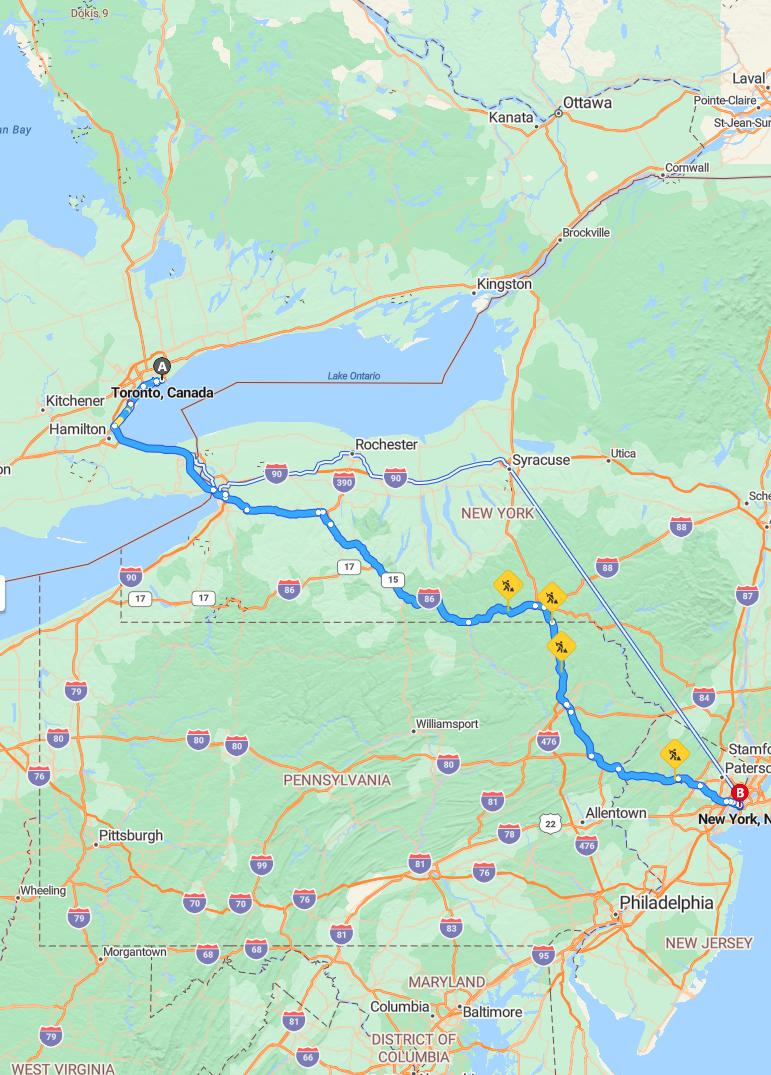Distance and estimated driving time
The drive from Toronto to New York covers approximately 471 miles via Queen Elizabeth Way and I-80, taking an estimated 8 hours. Travelers should plan for a long journey that includes potential traffic delays and necessary rest stops along the route. The scenic highway offers a mix of urban landscapes and countryside, providing a diverse driving experience. Prepared travelers can enjoy a smooth trip with proper planning and timely breaks.
Driving route
Embarking on a road trip from Toronto to New York City involves passing through several key cities. Starting in Toronto, Canada, travelers head south to Hamilton, known for its vibrant arts scene and steel industry. Continuing the journey, Rochester and Syracuse in New York offer cultural attractions and educational institutions, enriching the travel experience. As the route progresses, Utica and Albany provide a mix of historical sites and scenic landscapes, leading up to the bustling metropolis of New York City. This drive showcases a diverse array of urban, cultural, and natural sights across both countries, making it a memorable cross-border adventure.

Best time to depart for minimal traffic
To experience minimal traffic when driving from Toronto to New York City, it is advisable to depart early in the morning, around 4:00 or 5:00 am, especially during weekdays. Traveling during these hours allows you to avoid peak rush hours in major cities like Toronto, Rochester, and Albany, which tend to be busiest from 7:00 am to 9:00 am and later in the evening. Additionally, leaving early helps you bypass potential delays caused by construction, accidents, or heavy commuter traffic along your route. Planning your departure on a weekday, preferably Tuesday or Wednesday, can further help you enjoy a smoother journey with less congestion.
Road conditions and travel advisories
Travelers driving from Toronto to New York should stay informed about current road conditions and travel advisories, as weather and construction activities can impact the journey. In Ontario, road conditions are typically clear, but winter storms may cause delays, especially around Hamilton. Upon entering the United States, travelers should be aware of ongoing construction and possible lane closures in Rochester and Syracuse, which could affect travel times. It is advisable to check for real-time updates from transportation authorities along the route, particularly through upstate New York, to ensure a smooth and safe trip.
Toll costs and payment options
Traveling from Toronto to New York involves crossing several toll roads, particularly in New York State. Toll costs vary depending on the route taken, with major charges in areas like Rochester, Syracuse, and around the New York City metropolitan region, potentially totaling around $40 to $50. Drivers can pay tolls using various options such as cash, electronic toll transponders like E-ZPass, or credit/debit cards at toll booths where cash is accepted. Utilizing an E-ZPass can provide convenience and discounts on toll fees, making it the most efficient payment method for frequent travelers along this route.
Places to stop for fuel and breaks
When driving from Toronto to New York City, travelers can find convenient fuel and break stops along the route. In Hamilton, there are numerous gas stations and cafes to recharge before heading south into the United States. Rochester and Syracuse offer well-established rest areas with fuel stations, restrooms, and food options for a quick pause. As you approach Albany and Poughkeepsie, various service plazas and local gas stations make it easy to refuel and take breaks before reaching the bustling streets of New York City.
Accommodation options along the route
Travelers driving from Toronto to New York City have a variety of accommodation options along the route. In larger cities like Toronto, Rochester, Syracuse, Albany, and New York, there are numerous hotels, motels, and boutique inns to suit different budgets and preferences. Smaller towns such as Hamilton, Utica, and Poughkeepsie also offer cozy bed and breakfasts, charming inns, and budget-friendly hotels for overnight stays. Booking in advance is advisable, especially during peak travel seasons, to secure the best accommodations and ensure a comfortable journey.
Important travel documents and border crossing tips
When traveling from Toronto to New York, it's essential to carry valid travel documents such as a passport or a trusted traveler card like NEXUS for smooth border crossings. Ensure that your documents are up-to-date and easily accessible, as customs may require verification of your identity and citizenship. Be prepared to answer questions about your travel plans and declare any items you're bringing into the United States. Additionally, familiarize yourself with U.S. customs regulations and restrictions to avoid delays or confiscation of prohibited goods during your journey through Hamilton, Rochester, Syracuse, Utica, Albany, and Poughkeepsie before entering New York City.
Safety tips for cross-border driving
When driving from Toronto to New York, it is essential to prioritize safety throughout your journey. Be sure to carry all required documents, such as your passport and any necessary visas, for seamless border crossing. Stay aware of international traffic laws and speed limits, and keep your vehicle in good condition to prevent breakdowns. Additionally, plan your route in advance, take regular breaks to avoid fatigue, and remain vigilant for changing road conditions and signage in different regions.
Local laws and driving regulations in New York
When driving in New York, it is important to adhere to the state's specific traffic laws and regulations. The legal speed limit in urban areas is typically 30 mph unless otherwise posted, and seat belts are required for all passengers. Drivers must also observe strict rules regarding turning and parking, with many zones enforcing restrictions during certain hours. Additionally, the use of handheld electronic devices while operating a vehicle is prohibited, and drivers should be aware of tolls along major highways like the New York State Thruway.
